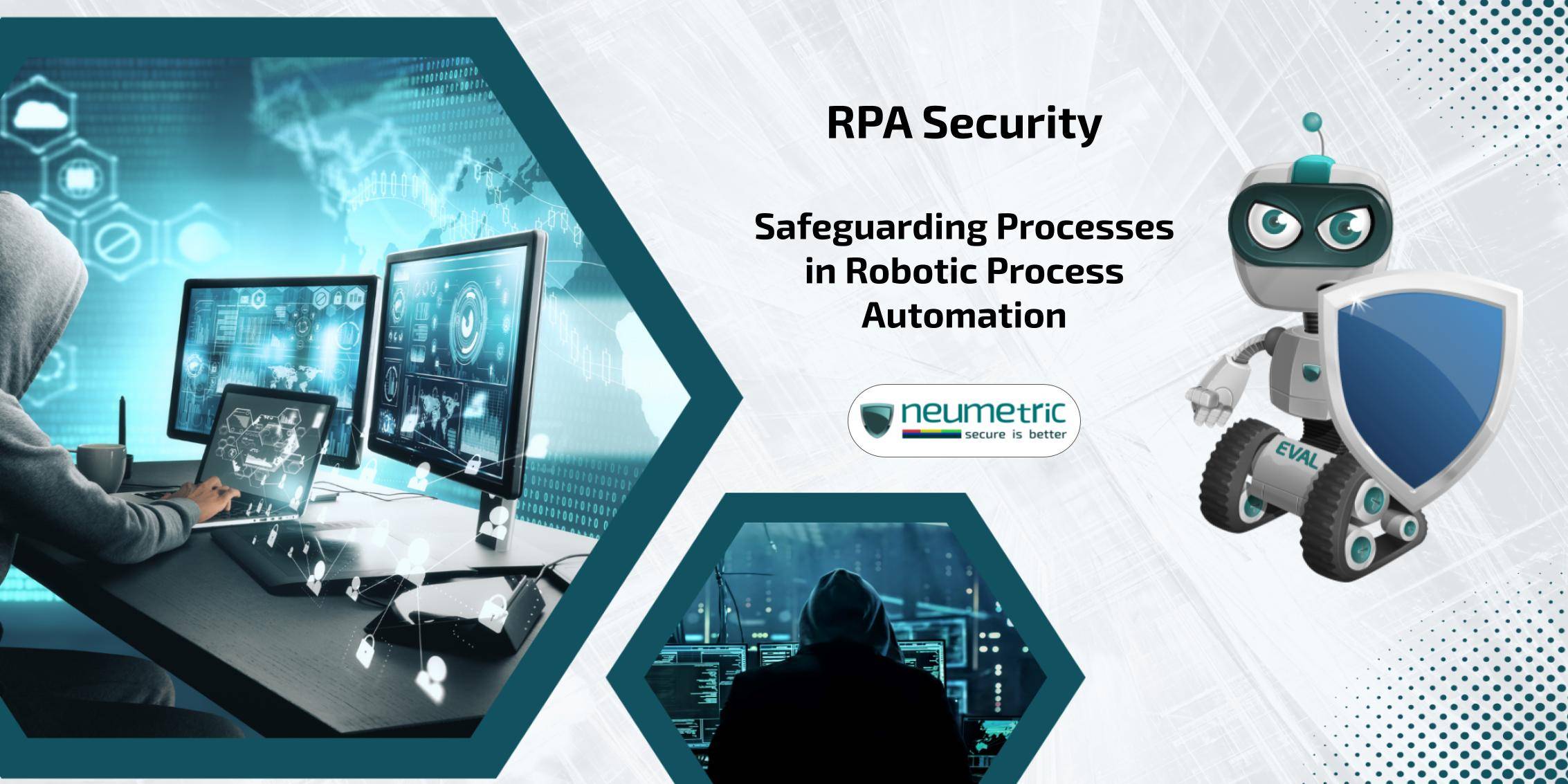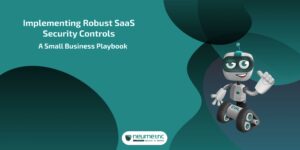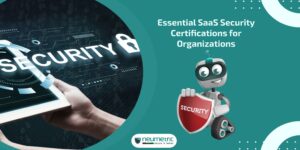Table of Contents
ToggleIntroduction
In today’s rapidly evolving digital landscape, Robotic Process Automation (RPA) stands as a pivotal technological advancement revolutionising businesses’ operational efficiency. RPA, the use of software robots or “bots” to automate repetitive tasks, has significantly transformed workflows across industries, offering unparalleled speed, accuracy & scalability.
However, amid this transformative wave, the critical discussion of RPA security surfaces as a paramount concern. While RPA promises streamlined operations & increased productivity, the potential vulnerabilities & security risks associated with its implementation cannot be overlooked.
It is important to delve into the intricate realm of RPA Security, shedding light on the essential considerations, potential threats, best practices & future trends to safeguard processes within Robotic Process Automation.
Understanding RPA Security
At the heart of the transformative power of Robotic Process Automation (RPA) lies the seamless integration of software robots to execute mundane & repetitive tasks with precision. Yet, amidst this unparalleled efficiency, a crucial facet demands our attention: RPA Security.
RPA Security refers to the robust measures & protocols implemented to safeguard automated processes against potential vulnerabilities, breaches & unauthorised access. To comprehend the nuances of RPA Security, it’s imperative to dissect the various layers of vulnerability that may encircle the otherwise efficient automation framework.
RPA systems, like any other technological innovation, are not immune to risks. Understanding the intricacies of these vulnerabilities becomes paramount in establishing a fortified defence system that ensures the integrity, confidentiality & availability of sensitive data & processes orchestrated by RPA.
Common RPA Security Threats
The unprecedented integration of Robotic Process Automation (RPA) into the operational fabric of businesses has ushered in an era of unparalleled efficiency. However, this groundbreaking transformation is not without its challenges, especially concerning the security landscape.
As RPA systems seamlessly automate processes, they inadvertently present a surface area vulnerable to various threats. Understanding these threats becomes paramount in fortifying the robustness of RPA implementations & safeguarding against potential breaches.
Unauthorised Access to RPA Systems
One of the foremost concerns in RPA Security is unauthorised access. As RPA bots operate within intricate networks & systems, any breach of access control mechanisms can potentially grant unauthorised individuals or entities entry into critical systems, leading to data compromise or manipulation.
Data Leakage & Integrity Issues
RPA involves the handling & processing of sensitive data. Any compromise in the secure handling of this data can result in leaks or alterations, leading to severe integrity issues. Protecting the confidentiality & integrity of this data is pivotal in maintaining trust & compliance.
Malicious Script Injection
RPA bots operate by following predefined scripts or instructions. However, if these scripts are tampered with through malicious injections, the bots can be manipulated to perform unauthorised actions, potentially causing significant disruptions or allowing access to restricted systems.
Lack of Secure Coding Practices
Inadequate attention to secure coding practices within the RPA development process can open doors to vulnerabilities. Failure to follow established security protocols & best practices may create loopholes that threat actors could exploit.
Understanding these prevalent threats enables organisations to proactively fortify their RPA ecosystems, implement robust security measures & develop resilience against potential breaches or compromises.
Best Practices for RPA Security
Robotic Process Automation (RPA) systems, while revolutionising operational efficiency, demand a proactive approach to security to mitigate potential vulnerabilities. Implementing robust security practices is crucial to fortify RPA ecosystems against threats & ensure the integrity of automated processes.
Implement Role-Based Access Control (RBAC)
- Definition of Roles & Privileges: Clearly define roles & permissions for users accessing RPA systems.
- Access Limitation: Restrict access based on job responsibilities to prevent unauthorised usage or modification of automation scripts.
Encryption & Data Protection Measures
- Data Encryption: Encrypt sensitive data at rest & in transit to prevent unauthorised access.
- Secure Data Handling: Implement secure data storage & transmission protocols to maintain confidentiality.
Regular Security Audits & Assessments
- Periodic Evaluations: Conduct routine security audits to identify vulnerabilities & assess system integrity.
- Penetration Testing: Perform simulated attacks to uncover weaknesses & reinforce security measures.
Training & Awareness Programs
- Employee Education: Provide comprehensive training to RPA users on security protocols & best practices.
- Promote Security Culture: Foster a culture of cybersecurity awareness to mitigate human errors & oversights.
Secure Development Lifecycle
- Adherence to Secure Coding Practices: Follow established security guidelines during the development of RPA scripts.
- Continuous Monitoring: Implement continuous monitoring tools to identify & rectify security gaps during development.
Incident Response & Recovery Plans
- Preparation for Breach Incidents: Develop robust incident response plans to swiftly address & contain security breaches.
- Data Recovery Protocols: Establish recovery procedures to restore data integrity in case of breaches or system failures.
Adopting these best practices fosters a proactive approach to RPA security, strengthening defences against potential threats & ensuring the seamless & secure functioning of automated processes.
RPA Security Tools & Technologies
Securing Robotic Process Automation (RPA) environments involves the strategic utilisation of specialised tools & technologies tailored to fortify automated processes against potential threats.
Encryption Solutions
- Data Encryption Software: Tools offering robust encryption algorithms to secure sensitive data at rest & during transmission.
- Tokenization Platforms: Solutions that tokenize sensitive information to protect its confidentiality.
Access Control & Identity Management
- Identity & Access Management (IAM) Systems: Platforms managing user identities & their access privileges within RPA systems.
- Privileged Access Management (PAM) Tools: Tools ensuring controlled access to critical systems & functionalities.
Security Analytics & Monitoring
- Security Information & Event Management (SIEM) Software: Solutions enabling real-time monitoring & analysis of RPA-related security events.
- Behavioral Analytics Tools: Technologies identifying anomalous behaviour within RPA processes for proactive threat detection.
Vulnerability Assessment & Penetration Testing
- Vulnerability Scanning Tools: Software conducting automated scans to identify vulnerabilities within RPA environments.
- Penetration Testing Services: Professional services simulating cyber-attacks to identify weaknesses & gaps in security measures.
Secure Coding & Development
- Integrated Development Environments (IDEs) with Security Plugins: Tools equipped with security plugins aiding in adherence to secure coding practices.
- Code Analysis Tools: Solutions performing static & dynamic analysis of RPA scripts for potential vulnerabilities.
Automation-Specific Security Platforms
RPA Security Platforms: Tailored security solutions designed specifically for RPA environments, offering comprehensive security features.
Blockchain for RPA Security
Blockchain Integration: Utilising blockchain technology to enhance data integrity & security within RPA ecosystems.
These tools & technologies play a pivotal role in fortifying RPA systems, enabling organisations to implement comprehensive security measures, mitigate risks & maintain the integrity of automated processes.
Compliance & Regulatory Considerations in RPA Security
Robotic Process Automation (RPA) implementations must adhere to various regulatory frameworks & compliance standards to ensure the secure handling of data & processes.
GDPR (General Data Protection Regulation)
- Data Handling & Consent: Ensuring RPA processes comply with GDPR’s stringent requirements regarding data handling & user consent.
- Data Protection Impact Assessments (DPIAs): Conducting DPIAs to evaluate & mitigate risks associated with RPA data processing activities.
HIPAA (Health Insurance Portability & Accountability Act)
- Protected Health Information (PHI) Handling: Implementing strict controls to safeguard PHI processed through RPA systems.
- Healthcare Data Encryption: Ensuring encryption of sensitive healthcare data in line with HIPAA mandates.
SOX (Sarbanes-Oxley Act)
Financial Data Integrity: Ensuring RPA processes comply with SOX regulations for maintaining the integrity of financial data & preventing fraud.
Industry-Specific Regulations
Industry Compliance Standards: Adhering to specific industry regulations such as PCI-DSS for payment card industry compliance or FISMA for government agencies.
International Data Transfer Regulations
Data Transfer Protocols: Complying with regulations governing the transfer of data across international borders, such as Privacy Shield or Binding Corporate Rules (BCRs).
Emerging Regulatory Trends
AI & Automation Regulations: Monitoring evolving regulations concerning AI & automation technologies, anticipating their impact on RPA security.
Compliance with these regulations is crucial in maintaining the trust of stakeholders, avoiding legal liabilities & ensuring the ethical & secure use of RPA technologies.
Future Trends & Innovations in RPA Security
As technology continues to evolve, the landscape of Robotic Process Automation (RPA) security is poised for advancements & innovations.
AI & Machine Learning Integration
- Enhanced Threat Detection: Leveraging AI & ML algorithms to proactively identify & mitigate emerging threats within RPA systems.
- Behavioural Analytics: Implementing advanced analytics to detect anomalous behaviour in real-time & prevent potential security breaches.
Zero Trust Architecture (ZTA)
- Continuous Verification: Embracing ZTA principles to verify every access request within RPA environments, minimising the trust assumption.
- Micro-Segmentation: Implementing granular access controls & segmentation within RPA systems for enhanced security.
Homomorphic Encryption
Secure Data Processing: Utilising homomorphic encryption to perform computations on encrypted data without decrypting it, ensuring privacy & security.
Privacy-Preserving Technologies
Differential Privacy: Implementing techniques to anonymize data & protect individual privacy within RPA operations.
Quantum-Safe Cryptography
Preparing for Quantum Computing: Adopting cryptographic algorithms resilient to quantum attacks to future-proof RPA security.
Convergence of Cybersecurity & RPA
Integrated Security Solutions: Developing unified cybersecurity solutions specifically designed to fortify RPA environments.
Autonomous Security Measures
Self-Healing Systems: Implementing autonomous security mechanisms within RPA ecosystems to identify & mitigate threats without human intervention.
The integration of these emerging trends & innovations signifies the evolution of RPA security measures, promising more robust, adaptive & resilient systems in the face of evolving cyber threats.
Conclusion
The exploration into RPA Security reveals the pivotal role of fortifying automated processes against threats & vulnerabilities. As Robotic Process Automation (RPA) reshapes operational efficiency, securing these workflows becomes paramount. Understanding threats, implementing best practices, adhering to compliance & anticipating future trends are foundational. Proactive security isn’t merely reactive; it demands constant vigilance & adaptation to evolving threats. AI-driven threat detection, quantum-safe cryptography & collaborative cybersecurity approaches pave the way for resilient RPA ecosystems.
Looking ahead, collaboration between RPA developers, cybersecurity experts & regulators is essential. A culture of adaptation & innovation is key to outmanoeuvring threats. With this proactive stance & embracing emerging technologies, businesses can ensure secure & efficient RPA environments.
FAQ
Why does RPA Security matter for businesses?
RPA Security safeguards automated processes, preventing unauthorised access & data breaches, ensuring data integrity & compliance.
What practices strengthen RPA Security?
Implementing access controls, encryption, regular audits, employee training, secure coding & compliance measures fortify RPA Security.
How does RPA Security comply with regulations like GDPR & HIPAA?
RPA Security aligns with GDPR’s data protection & consent rules & maintains strict controls for sensitive healthcare data under HIPAA.
What upcoming trends are shaping RPA Security?
Emerging trends include AI-driven threat detection, Zero Trust Architecture, privacy-preserving tech like homomorphic encryption & quantum-safe cryptography.
Why is collaboration vital for securing RPA processes?
Collaborative efforts between RPA developers, cybersecurity experts & regulators anticipate threats, adapt security measures & ensure a secure RPA future





